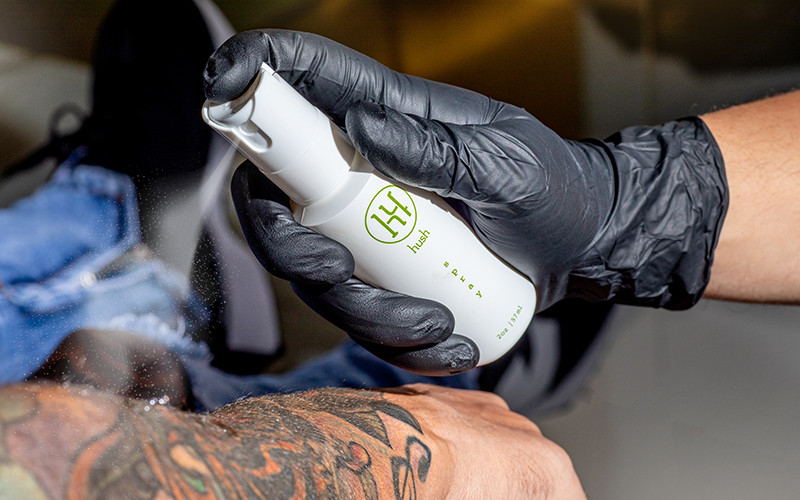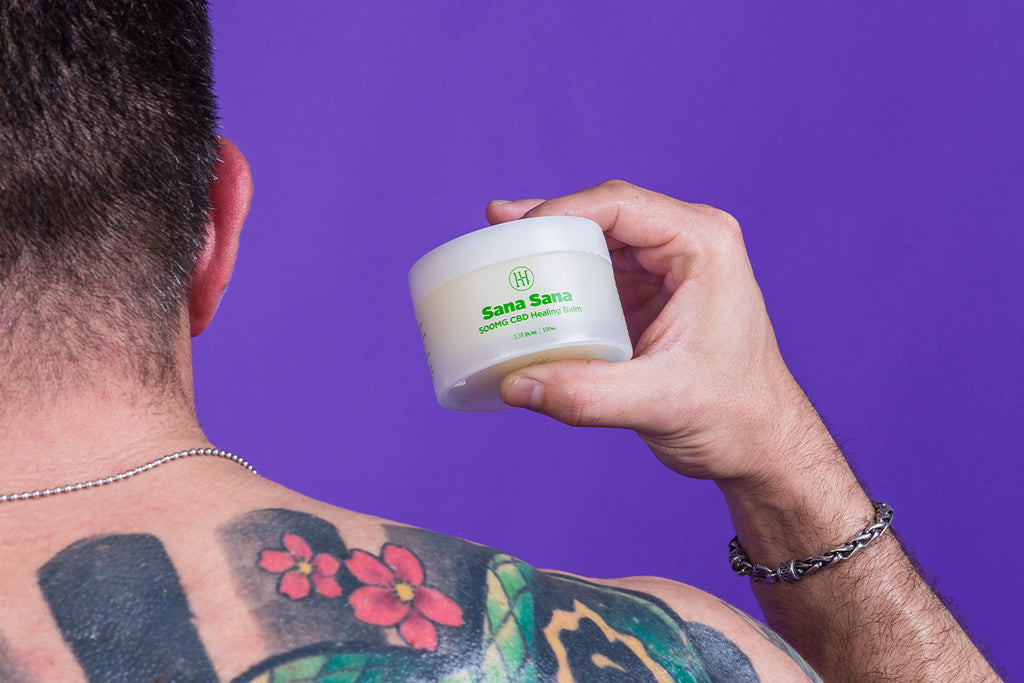Why Do New Tattoos Peel? Peeling is a completely normal part of the tattoo healing journey, indicating your body is repairing the skin after the tattoo process; consider it a natural exfoliation process. At tattooat.com, we understand you want the best for your body art, so we are here to guide you through the peeling phase, ensuring vibrant and long-lasting results with proper tattoo aftercare. Learn about tattoo healing, aftercare tips, and identifying potential issues to protect your investment.
1. What is Tattoo Peeling?
Tattoo peeling is a natural exfoliation process that occurs as your skin heals after getting a tattoo. The epidermis, or the top layer of skin, sheds dead skin cells, revealing the newly tattooed skin underneath. Tattoo ink is injected into the dermis, the layer of skin beneath the epidermis, so this peeling process doesn’t affect the tattoo itself. The tattoo may appear dull during this phase, but it will regain its vibrancy once the peeling is complete.
Generally, you’ll begin noticing peeling skin on and around your tattoo within a week after removing the bandage. You might also observe scabbing during the second week of the tattoo recovery. It’s important to resist the urge to pick at the peeling skin or scabs, allowing the skin to heal naturally.
2. Can Tattoo Peeling Damage a Tattoo?
Peeling is part of the normal healing process; however, improper handling can harm your tattoo. Knowing the difference between normal and abnormal peeling, and how to care for your skin, is essential for preserving your tattoo’s appearance.
2.1. How To Tell the Difference Between Normal Peeling and Bad Peeling
Identifying the type of peeling you’re experiencing can prevent potential tattoo damage.
Normal Peeling:
- Resembles light flaking.
- Starts within a week after getting your tattoo.
- Lasts about a week.
- Flakes are thin, sometimes with tiny bits of color.
Bad Peeling:
- Involves intense peeling with redness or swelling.
- Skin feels hot to the touch.
- May be accompanied by pus, unpleasant odor, or excessive pain.
- Thick scabs that appear to pull away from the tattoo.
If you suspect bad peeling, consult your tattoo artist or a healthcare professional. Early intervention can prevent further complications.
 Normal tattoo peeling vs infected tattoo
Normal tattoo peeling vs infected tattoo
3. Should I Help the Peeling Skin Come Off of My Tattoo?
No, it’s important not to help the peeling skin come off your tattoo. While it can be tempting to speed up the process, picking or pulling at the peeling skin can damage your tattoo by removing ink and skin cells that are still healing. Instead, be patient and allow the dead skin to flake off naturally, which will happen when you shower or moisturize. If you find yourself wanting to pick at the peeling skin, try covering the tattoo with loose clothing to keep it out of sight.
4. What Happens If I Peel My Tattoo and Damage It?
It’s crucial to avoid peeling your tattoo, as it can lead to several negative consequences. Intentionally removing peeling skin can result in uneven healing, increased risk of scarring, risk of infection, and the need for expensive touch-ups.
4.1. Uneven Healing
Removing skin prematurely can disrupt the ink distribution, resulting in patchy areas with inconsistent coloring. This is similar to peeling paint off a wall, where some areas are bare while others retain jagged stripes of color.
4.2. Increased Risk of Scarring
Picking and peeling can cause deep scabs to form. If these scabs are disturbed, they can lead to scarring, resulting in raised areas on the tattoo. Scarring can permanently affect the texture and appearance of the tattoo, potentially preventing future touch-ups or cover-ups.
4.3. Risk of Infection
During the healing phase, your tattoo is essentially an open wound, making it susceptible to bacterial infections if the skin is peeled prematurely. This can lead to swelling, oozing, and intense pain, potentially ruining the tattoo altogether.
4.4. Expensive Touch-Ups
Damaging your tattoo by peeling off skin may require touch-up sessions to restore its appearance. While some artists offer free touch-ups for minor fixes, they typically don’t cover damage caused by improper aftercare. Avoiding peeling can save you from incurring additional costs.
Remember, your tattoo artist put a lot of effort into creating a unique piece of art for you. Damaging your tattoo by intentionally ripping away at your skin can be disheartening for both you and the artist. Always follow aftercare instructions carefully and ask questions if you’re unsure about anything during the healing process.
5. What Do I Do if My Tattoo Is Peeling?
During the peeling phase, protect and soothe your sensitive skin by following a proper aftercare routine. This includes washing the tattoo gently, moisturizing regularly, and soothing any discomfort with appropriate products.
5.1. Should You Wash Your Tattoo While It’s Peeling?
Yes, it’s important to keep your tattoo clean while it’s peeling. Cleaning the area helps prevent infection, as a new tattoo involves puncturing the skin thousands of times, creating opportunities for bacteria to enter. Keeping your tattoo clean can also speed up the healing process.
5.2. What Should I Use to Moisturize My Peeling Tattoo?
 Hush Numbing Gel
Hush Numbing Gel
Use a high-quality moisturizer, lotion, or tattoo aftercare cream to hydrate the tattoo. A good aftercare cream can relieve itching and support the healing process by providing essential vitamins and minerals. For example, HUSH tattoo care products are formulated with a combination of healing and soothing elements. Moisturizers also create a protective barrier, allowing the tattoo to heal properly.
5.3. How Can I Soothe My Tattoo During the Peeling Stage?
Itchiness is a common symptom as your tattoo peels, revealing new skin underneath. To alleviate discomfort, consider using a tattoo numbing spray containing lidocaine. This can help reduce itching and provide relief. Follow directions carefully to avoid damaging the tattoo.
5.4. How Can I Protect My New Tattoo?
Protecting your new tattoo during the peeling stage involves using appropriate aftercare products and taking precautions to avoid irritation and damage. Start by cleaning the area with a gentle cleanser, such as HUSH CBD Foam Soap, to remove bacteria and promote healing. Also, protect your new tattoo from the sun. Sunburns can cause infection and disrupt or discolor your tattoo, potentially requiring touch-ups. Apply sunscreen regularly and wear loose clothing over the tattoo when possible.
6. What Are the Symptoms of Tattoo Peeling?
The symptoms of tattoo peeling include itchiness, dry skin on and around the tattoo, and flakiness or shedding of skin in small or large pieces. However, not everyone experiences peeling, and the absence of peeling doesn’t indicate a problem with the tattoo. If you notice swelling, excessive redness, or bumps around the tattoo, consult a doctor, as these could be signs of an infection.
7. What To Avoid With a Peeling Tattoo?
When dealing with a peeling tattoo, there are several things you should avoid to ensure proper healing.
7.1. Don’t Panic
Peeling is a normal part of the healing process and does not necessarily indicate an infection. However, if you have concerns, consult your tattoo artist or a dermatologist.
7.2. Don’t Pick
Picking at the peeling skin can cause trauma to the area and potentially remove ink, resulting in patchy spots. Allow the tattoo to heal naturally to retain maximum color and brightness.
7.3. Don’t Scratch
Scratching can damage the sensitive, healing area and disturb the newly placed ink, leading to patchy spots. Use aftercare products like HUSH Numbing Spray and CBD Healing Balm to relieve itchiness without causing damage.
7.4. Don’t Wear Tight Clothes
Tight clothing can rub against the healing tattoo, causing irritation. Wear loose clothing to allow the tattoo to breathe and heal properly.
8. How Long Does Tattoo Peeling Last?
The duration of tattoo peeling varies from person to person, with some experiencing no peeling and others taking up to a month to fully heal. Peeling and scabbing typically begin during the first week of healing, with redness fading by the second week. By following proper aftercare instructions and contacting your tattoo artist with any concerns, you can ensure a smooth healing process.
9. Is My Tattoo Peeling or Infected?
It’s important to distinguish between normal tattoo peeling and signs of infection. While sterile equipment minimizes infection risk, allergic reactions or immune responses can still occur.
9.1. Symptoms of an Infected Tattoo
Infected tattoos differ significantly from normal peeling tattoos. Symptoms of an infected tattoo include:
- Bumps on the skin, potentially with pus inside.
- Larger nodules underneath the skin.
- Worsening redness and swelling.
- Pain and soreness in the tattoo area.
- Chills or fever.
If you experience any of these symptoms, seek medical attention immediately to prevent serious complications.
 Tattoo Aftercare Balm
Tattoo Aftercare Balm
10. FAQ About Tattoo Peeling
Here are some frequently asked questions about tattoo peeling:
- Is peeling a sign that my tattoo is fading? No, peeling is a normal part of the healing process and doesn’t necessarily mean your tattoo is fading.
- Can I use regular lotion on my peeling tattoo? It’s best to use a tattoo aftercare cream or a gentle, fragrance-free lotion to moisturize your peeling tattoo.
- How often should I moisturize my peeling tattoo? Moisturize your tattoo several times a day, or whenever it feels dry or itchy.
- Can I go swimming with a peeling tattoo? It’s best to avoid swimming until your tattoo is fully healed to prevent infection.
- Is it normal for my tattoo to itch while it’s peeling? Yes, itching is a common symptom of tattoo peeling.
- Can I use sunscreen on my peeling tattoo? Yes, but make sure to use a gentle, fragrance-free sunscreen specifically designed for sensitive skin.
- What should I do if my tattoo is peeling excessively? If your tattoo is peeling excessively, consult your tattoo artist or a healthcare professional for advice.
- Can I wear bandages on my peeling tattoo? It’s best to avoid wearing bandages on your peeling tattoo unless specifically advised by your tattoo artist or a healthcare professional.
- How long does it take for a tattoo to fully heal? It can take several weeks or even months for a tattoo to fully heal, depending on the size, location, and individual factors.
- When should I contact my tattoo artist or a doctor about my peeling tattoo? Contact your tattoo artist or a doctor if you experience signs of infection, excessive pain, or any other concerning symptoms.
Conclusion
 Tattoo Aftercare Set
Tattoo Aftercare Set
Peeling is a natural part of the tattoo healing process. At tattooat.com, we want your aftercare process to be easy and comfortable, so we provide guidance and recommendations for products like numbing sprays, CBD foam soaps, and CBD balms to soothe and protect your skin. Remember, proper aftercare is key to ensuring your tattoo looks its best for years to come.
Ready to explore stunning tattoo designs, connect with talented artists, and gain in-depth knowledge about tattoo aftercare? Visit tattooat.com today and embark on your tattoo journey with confidence. Find inspiration, expert advice, and the resources you need to make informed decisions about your body art.
Address: 1825 SW Broadway, Portland, OR 97201, United States
Phone: +1 (503) 725-3000
Website: tattooat.com
